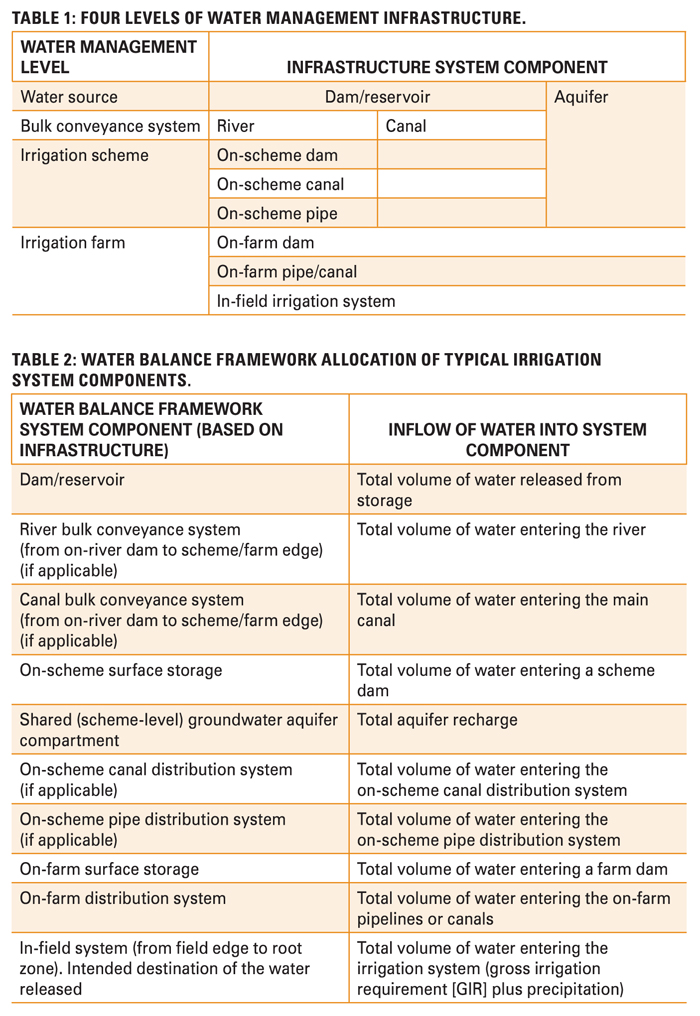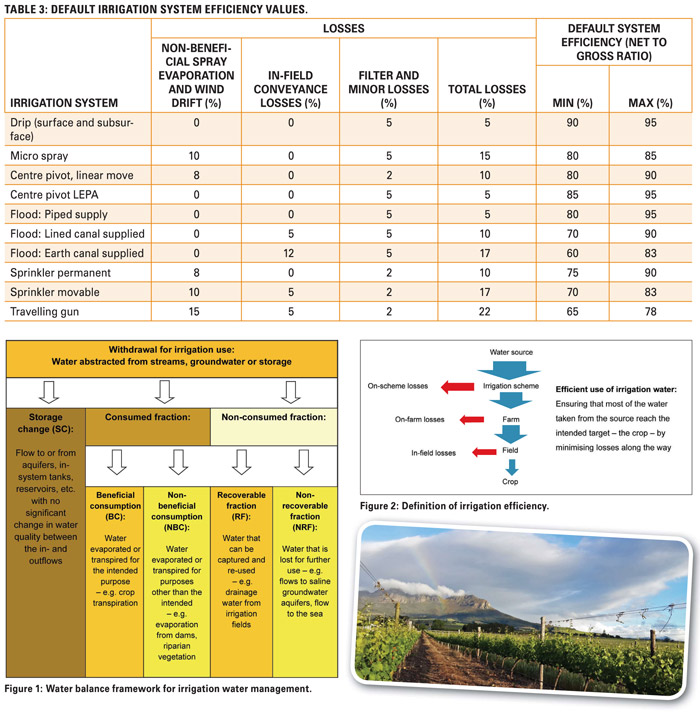October 2017
Through intensive research, the ARC-Agricultural Engineering, together with other disciplines, developed a South African framework for improved water efficiency. The framework was applied to re-assess the system efficiency indicators typically used by irrigation designers when making provision for losses in a system and converting net to gross irrigation requirements.
The project was funded by the Water Research Commission and the report ‘Standards and guidelines for improved efficiency of irrigation water use from dam wall release to root zone application’ was published recently and is now the approach in water use efficiency.
Success with irrigated farming can be obtained through efficient irrigation by applying and understanding the water balance approach. The water balance approach can be applied at any level, within defined boundaries, or across all levels to assess performance within the whole water management area.
Studies and research over 40 years in South Africa on the techniques of flood-, mobile- and micro-irrigation contributed to the knowledge base of applying irrigation methods correctly. The fraction of the water abstracted from the source that can be utilised by the plant, can be called the beneficial water use component and optimised irrigation water supply is therefore aimed at maximising this component.
In South Africa an area of 16 000 000 ha has been cultivated and 1 600 000 ha are being irrigated. With effective water management and good subsurface drainage, improved soil health conditions are being created for successful irrigation farming to assist with food security. The resulting approach of ‘measure, assess, evaluate, improve’, promotes an investigative water balance approach to improve water efficiency.
The basis of the water balance approach is that any water withdrawn from a catchment for irrigation use contributes either to storage change, to the consumed fraction, or to the non-consumed fraction at a point downstream of the point of abstraction. The water that is consumed will either be to the benefit of the intended purpose (beneficial consumption) or not (non-beneficial consumption). Water that is not consumed but remains in the system will either be recoverable (for re-use) or non-recoverable (lost to further use). The boundaries are as explained in Figure 1.
 In order to apply this framework to irrigation areas, typical water infrastructure system components are defined wherein different scenarios may occur. In South Africa, most irrigation areas consist of a dam or weir in a river from which water is released for the users to abstract, either directly from the river or in some cases via a canal. Water users can also abstract water directly from a shared source, such as a river or dam/reservoir, or the scheme-level water source could be a groundwater aquifer.
In order to apply this framework to irrigation areas, typical water infrastructure system components are defined wherein different scenarios may occur. In South Africa, most irrigation areas consist of a dam or weir in a river from which water is released for the users to abstract, either directly from the river or in some cases via a canal. Water users can also abstract water directly from a shared source, such as a river or dam/reservoir, or the scheme-level water source could be a groundwater aquifer.
Once the water enters the farm, it can either contribute to storage change (in farm dams), enter an on-farm water distribution system or be directly applied to the crop with a specific type of irrigation system.
The developed South African framework covers four levels of water management infrastructure, (as shown in Table 1): i.e. the water source, the bulk conveyance system, the irrigation scheme and the irrigation farm and the relevant water management infrastructure.
In order to improve water use efficiency in the irrigation sector, actions should be taken to reduce the non-beneficial consumption (NBC) and non-recoverable fraction (NRF).
Due to the fact that Table 2 has been drawn up from an irrigation system perspective, there is not much that the practitioner can do to recover water in some of the infrastructure components. In the case of irrigation, losses occur at different levels of water management as shown in Figure 2.

Unfortunately, historical reporting of irrigation efficiencies (such as ‘application efficiency’, ‘system efficiency’, ‘distribution efficiency’ and ‘transportation efficiency’) has resulted in the diminished understanding and scrutiny of the source or causes of losses. There is a widespread illusion that efficiency is fixed by the type of irrigation infrastructure used rather than to the way a particular system has been designed and managed. In the past, improving performance and efficiency were, incorrectly, only associated with an upgrade in infrastructure (e.g. a change in irrigation system).
The framework can also be applied to re-assess the system efficiency indicators typically used by irrigation designers when making provision for losses in a system and converting net to gross irrigation requirement. A total of 75 irrigation systems were evaluated and a new set of system efficiency (SE) values for design purposes was therefore developed. These values are illustrated in Table 3. These values should not be confused with Table 2’s values, because Table 2 provides the water balance framework from a holistic point of view and Table 3 provides only the irrigation system efficiency values.
System efficiency defines the ratio between net and gross irrigation requirements (NIR and GIR). NIR is therefore the volume of water that should be available to the crop as a result of the planned irrigation system and GIR is the volume of water supplied to the irrigation system that will be subject to the envisaged in-field losses.
The approach makes provision for the occurrence of non-beneficial spray evaporation and wind drift, in-field conveyance, filter and other minor losses. The sum of all these losses makes up the value in the column ‘Total losses’.
The default system efficiency values in the last column were obtained by subtracting the total losses from 100%. With this in mind, the system must also function optimally and be managed correctly to obtain these required results.
When an irrigation system is evaluated, the system efficiency value can be compared to these default values, and possible significant water loss components identified as areas for improvement. The approach is therefore more flexible and easier to apply than the original efficiency framework where definitions limited the applications. It should always be kept in mind that a system’s water application efficiency will vary from irrigation event to irrigation event, as the climatic, soil and other influencing conditions are never exactly the same.
Care should therefore be taken when applying the SE indicator as a benchmark, as it does not make provision for irrigation management practices. This can be determined as the ratio between the volume of water lost to non-beneficial spray evaporation and wind drift, in-field conveyance, filter and other minor losses and the volume of water entering the irrigation system for a specific period of time. The losses can also be expressed as a depth of water per unit area, rather than a volume. Improvements can therefore only be made by improved management practices and functionality.
In conclusion, it can be said that the water balance resulting approach of ‘measure, assess, evaluate, improve’, promotes an investigative water balance approach to improve irrigation efficiency to assist managers and designers alike to use this developed information and tool that incorporate both detail investigations with the flexibility to be applied at any level to improve irrigation system performance.
For more information, contact Felix Reinders at ReindersF@arc.agric.za.
Reference
Reinders, FB, Van der Stoep, I, Lecler, NL, Greaves, KR, Vahrmeijer, JT, Benadé, N, Du Plessis, FJ, Van Heerden, PS, Steyn, JM, Grové, B, Jumman, A and Ascough, G. 2010. Standards and guidelines for improved efficiency of irrigation water use from dam wall release to root zone application: Main report. WRC report no. TT 465/10. Volume 1 of 3. Water Research Commission: Pretoria, South Africa.
Publication: October 2017
Section: Focus on